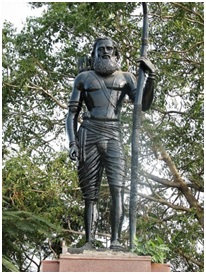

Context
Prime Minister unveiled a 30-foot-tall bronze statue of Alluri Sitharama Raju at Bhimavaram in Andhra Pradesh as the year-long celebrations of the freedom fighter’s 125th birth anniversary.
About
Alluri Sitharama Raju:
- Raju is believed to have been born in present-day Andhra Pradesh in 1897 or 1898.
- He is said to have become a sanyasi at the age of 18.
- He gained a mystical aura among the hill and tribal peoples with his austerity, knowledge of astrology and medicine, and his ability to tame wild animals.
- He channelled the discontent of the hill people in Ganjam, Visakhapatnam, and Godavari into a highly effective guerrilla resistance against the British.
- Colonial rule threatened the tribals’ traditional podu (shifting) cultivation, as the government sought to secure forest lands.
- The Forest Act of 1882 banned the collection of minor forest produce such as roots and leaves, and tribal people were forced into labour for the colonial government.
- While the tribals were subjected to exploitation by muttadars, village headmen commissioned by the colonial government to extract rent, the new laws and systems threatened their way of life itself.
- The Rampa or Manyam Rebellion continued in the form of a guerrilla war until May 1924, when Raju, the charismatic ‘ManyamVeerudu’ or Hero of Jungle, was finally captured and executed.

Recognition:
- In 1986, the Indian Postal Department issued a stamp in honour of Raju and his contribution to India’s struggle for Independence.
- In July 2019, on the occasion of Raju’s 122nd birth anniversary, the government of Andhra Pradesh announced the naming of a district after the legendary freedom fighter, acceding to a long-standing demand of the tribal population of Andhra Pradesh.
- The district of Alluri Sitharama Raju came into being in April 2022, made up of Paderu and Rampachodavaram of the existing districts of Visakhapatnam and East Godavari respectively.
- These two areas have tribal populations of 10.4 per cent and 4.1 per cent.


